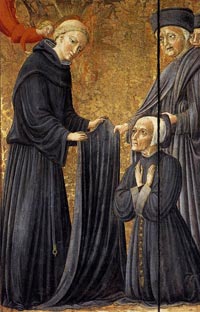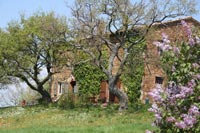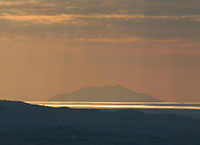 |
Vecchietta, Road to Calvary, fresco on the wall of the apse, Cathedral of Siena, 1447-50 |
Vecchietta (Lorenzo di Pietro)
|
Francesco di Giorgio e di Lorenzo (1412–June 6, 1480), known as Vecchietta or Lorenzo di Pietro, was one of the outstanding Sienese artists of the 15th century. He was a painter, sculptor, goldsmith, architect, and military engineer. He was probably trained by Sassetta, but he also came under the influence of Florentine art and his large-scale paintings have a monumentality rare in Siena in the quattrocento. He is said to have been the pupil of Taddeo Bartoli and Giacomo della Quercia. In sculpture he was influenced largely by Donatello, with whom he came into personal contact.
|
||||
Vecchietta was born in Castiglione d'Orcia, and lived in Siena. Much of his work may be found there, particularly at the Hospital of Santa Maria della Scala, lending him yet another name: pittor dello spedale (or 'painter of the hospital').
|
||||
|
||||
 |
 |
 |
||
Chiesa della Santissima Annunziata
|
Chiesa della Santissima Annunziata, interiore
|
Cristo Risorto, altare dellaChiesa della Santissima Annunziata dello Spedale di Santa Maria della Scala
|
||
 |
||
Vecchietta, The Founding of Spedale di Santa Maria della Scale, 1441, frescoin Spedale di Santa Maria della Scala, Siena. |
||
|
||
 |
||
Vecchietta, Arliquiera (1445), Pinacoteca Nazionale di Siena |
||
Vecchietta, Arliquiera (1445) |
||
| Vecchietta's Arliquiera, a painted wardrobe for holy relics painted by Vecchietta was placed in the Old Sacristy of Santa Maria della Scala in 1445, but is now in the National Picture Gallery of Siena. The Arliquiera is a wooden structure designed to enclose the hospital's precious relics in a niche in the wall of the sacristy of the Spedale di Santa Maria della Scala in Siena. Vecchietta's work in the sacristy started with the painting of the Arliquiera. On its outer face the Arliquiera displayed a series of saints and beati who were particularly revered in Siena and in the Spedale. Members of major religious orders were skilfully juxtaposed with members of the lay orders associated with them. Thus below the Dominican friar Ambrogio Sansedoni appeared the Dominican tertiary Catherine of Siena. Represented just above the massive metal bolts that secured the doors of the Arliquiera was the Blessed Agostino Novello, a figure of particular relevance to the Spedale. Believed to have written the rule for the hospital community of Augustinian tertiaries, this Augustinian friar is accordingly shown in the act of bestowing the mantle of office on the kneeling figure of a rector. Above this array of civic saints was placed a sequence of four paintings that portrayed in the outer compartments the Archangel Gabriel and the Virgin of the Annunciation and in the centre the Crucifixion and the Resurrection. While the first two figures alluded to the annual display of the relics to the public on the feast of the Annunciation, the second two scenes acted as a reminder of a prized relic held in the Arliquiera - one of the nails believed to have been used at the Crucifixion. The inner surfaces of the doors were painted with eight scenes depicting the Passion. Thus, when the doors were opened, the relics would have been framed by an entire sequence of paintings illustrating the key events that led up to the Crucifixion and Resurrection. [1] |
||
The picture The Blessed Agostino Novello shows one of the panels of the outer shutters of the Arliquiera. Believed to have written the rule for the hospital community of Augustinian tertiaries, Agostino Novello, an Augustinian friar, is accordingly shown in the act of bestowing the mantle of office on the kneeling figure of a rector - it seems reasonable to suppose that it may be intended as a portrait of Urbano di Pietro del Bello, who was rector of the Spedale between 1444 and 1450.
|
||
Pienza
|
||
| In the mid-1460s Pope Pius II commissioned four of Siena's leading painters to execute altarpieces for his newly completed cathedral in Pienza. These were the two slightly older painters Sano di Pietro and Giovanni di Paolo, the tried and tested Vecchietta, and a younger painter, Matteo di Giovanni. The cathedral was built by the Florentine architect Bernardo Rossellino according to the patron's taste for both Italian renaissance architecture and the tall, luminous interiors of north European churches, it was furnished entirely according to his preferences and wishes. Each of the four painters executed an altarpiece whose form and subject matter appears to have been closely controlled by their humanist patron. Vecchietta's takes the distinctive form of a kind of unified triptych, depicting the Virgin of the Assumption in the centre and pairs of saints on either side. These are Agatha, Pius, Calixtus and Catherine of Siena. Destined to be placed over the altar in the chapel to the left of the central chapel (when facing towards it), its subject honoured the dedication of the cathedral to the Virgin of the Assumption; the identities of the patron, Pius II, and his own patron and papal predecessor, Pope Calixtus III; and the Sienese saint whom Pius had canonised in 1461. While recalling the original design and gilded magnificence of the patronal altarpieces for Siena cathedral, this altarpiece was rendered in a notably contemporary manner, the framework adopting the repertoire of Renaissance architecture - simple, rectangular mouldings and a round (not pointed) arch, surmounted by a triangular pediment. The central image of the Virgin of the Assumption also demonstrates Vecchietta's confident handling of pictorial spaces, both in terms of the angels grouped in a circle below the seated figure of the Virgin and in the lyrical landscape behind the figure of Saint Thomas in the lower foreground. The pairs of saints on either side of this image stand on a pavement embellished with circles, likewise seen in depth. These saints too are portrayed as substantial figures who relate to one another. [2] |
 The Virgin of the Assumption with Saints, Cathedral, Pienza The Virgin of the Assumption with Saints, Cathedral, Pienza |
|
| Vasari's Lives of the Artists | The Life of Francesco di Giorgio Martini (1439-1502) and the Life of Lorenzo Vecchietto (ca. 1412-1480) [0] Keith Christiansen, Giving Voice to the Renaissance in Siena, The New York Times, Published: June 20, 1993. Keith Christiansen is a curator of European paintings at the Metropolitan Museum of Art. [1] Web Gallery of Art | Vecchietta, Arliquiera (outer shutters), 1445, Tempera on panel, 273 x 187 (each shutter), Pinacoteca Nazionale, Siena [2] Web Gallery of Art | Vecchietta, The Virgin of the Assumption with Saints, 1462-63, Cathedral, Pienza |
 |
|
| Tavoletta di Biccherna - Vecchietta, Incoronazione di Pio II, veduta di Siena fra due chimere, Archivio di Stato di Siena, 1460 | ||
The Villa Certano estate extends along the sunny, open hillside about 7 kilometres from Siena. Inside the estate, on top of a hill, is the ancient rural village with its stately manor-house dominating the tufaceous, sandy, browny-yellow terrain, typical of this area, where olives and grapes have been cultivated for centuries. Villa Certano has belonged to the Baldassarrini Macinelli family for centuries and during the Renaissance it was the property of the famous Sienese painter and architect, Lorenzo di Pietra Vecchietta, who made this his residence.
|
||












